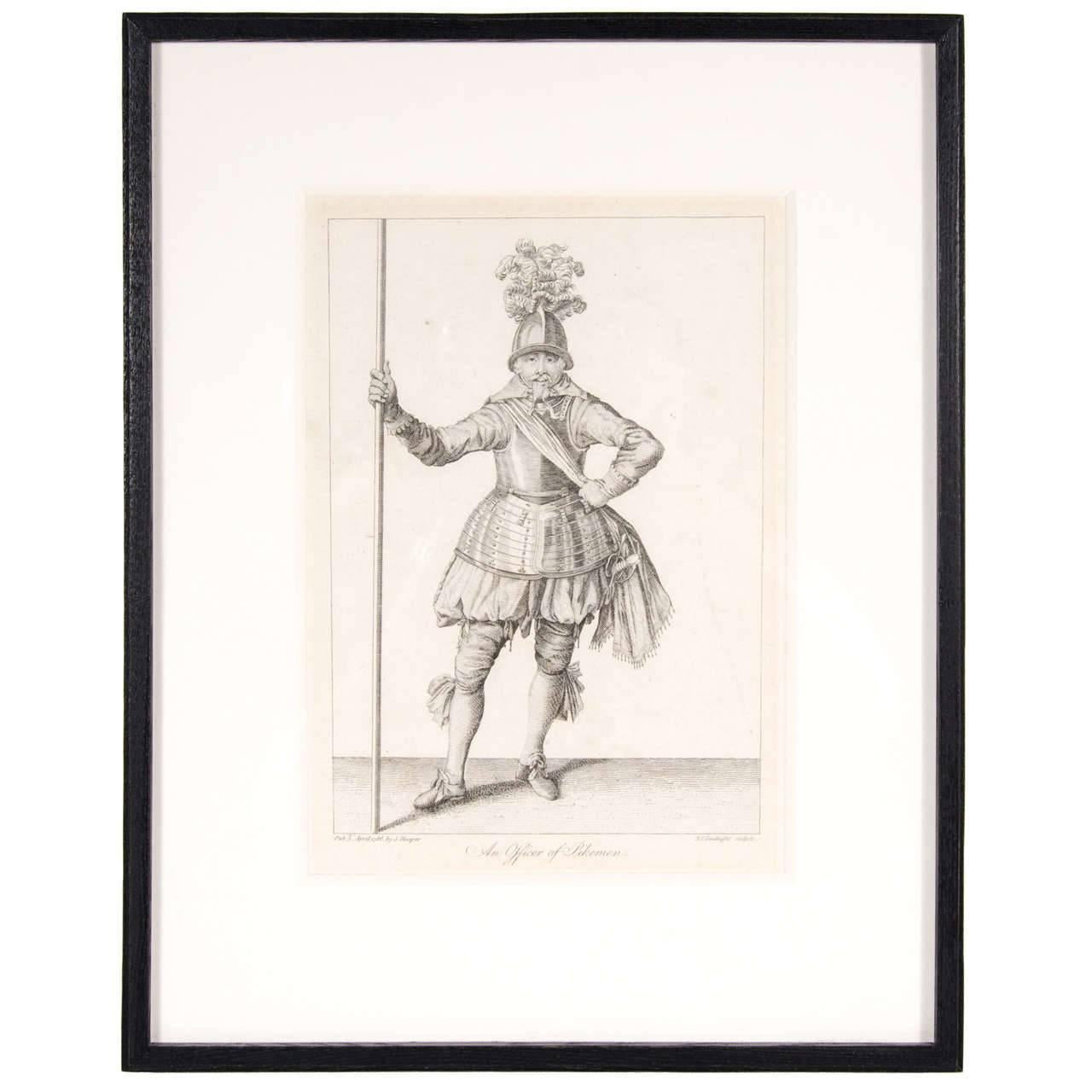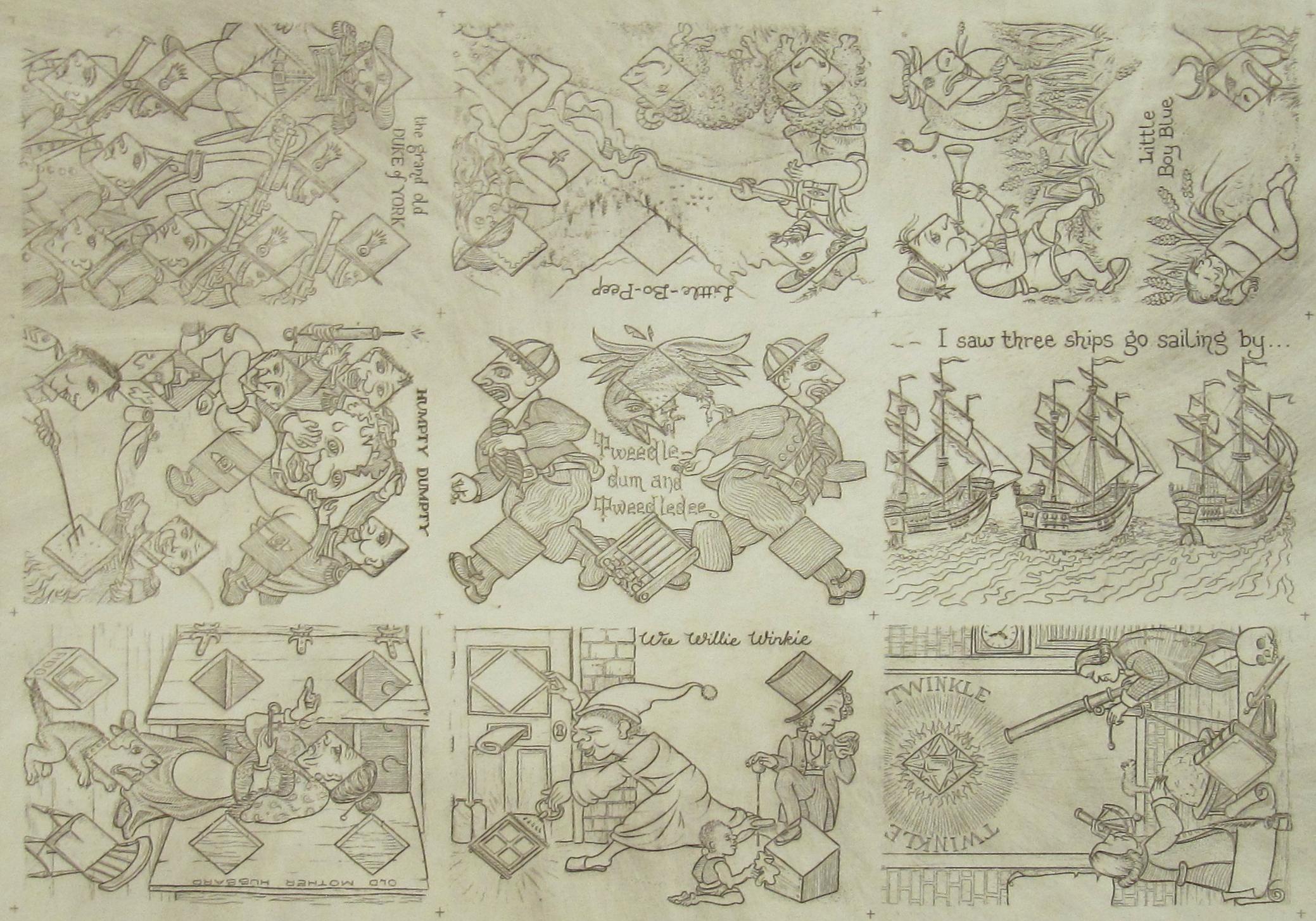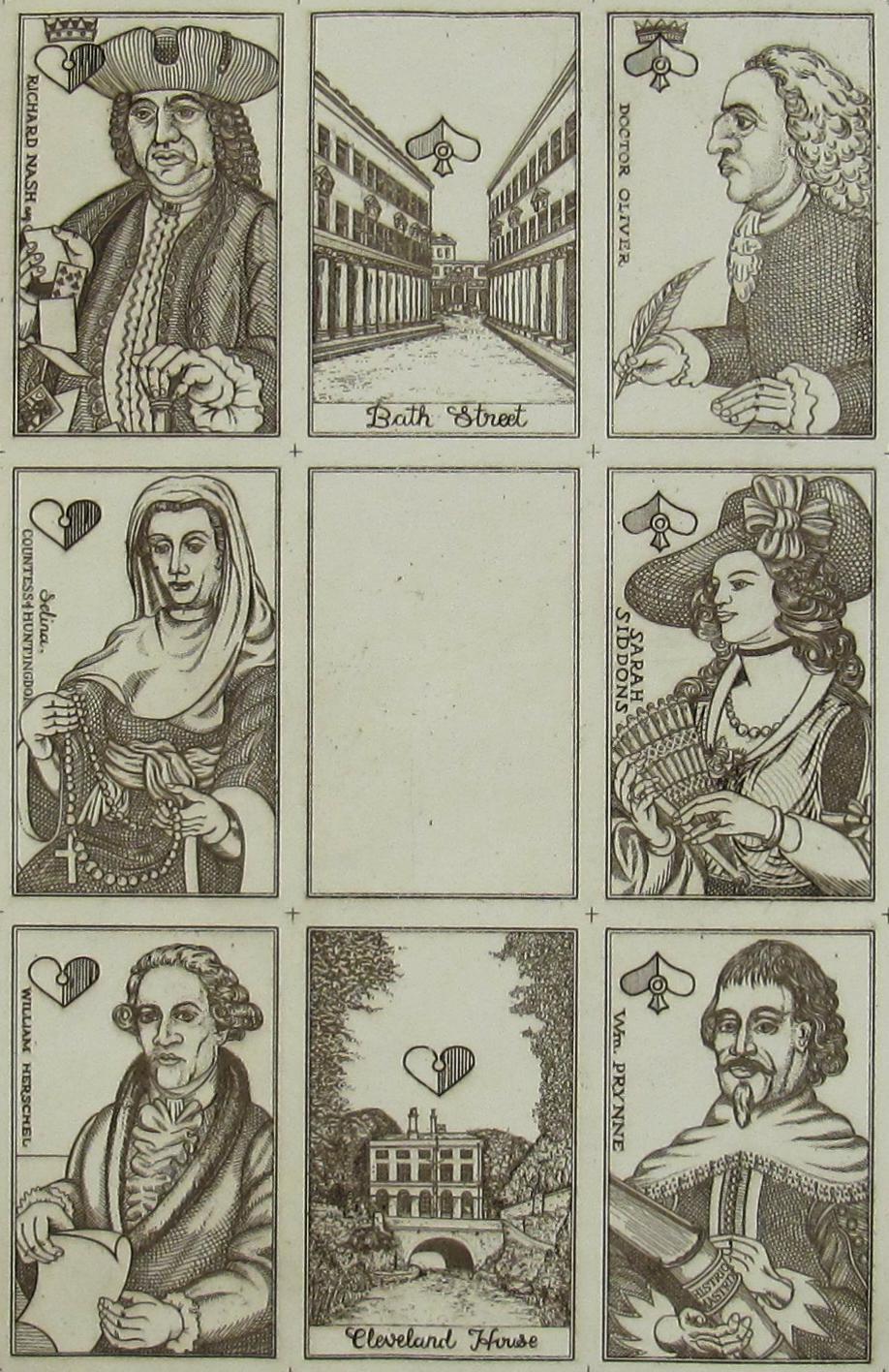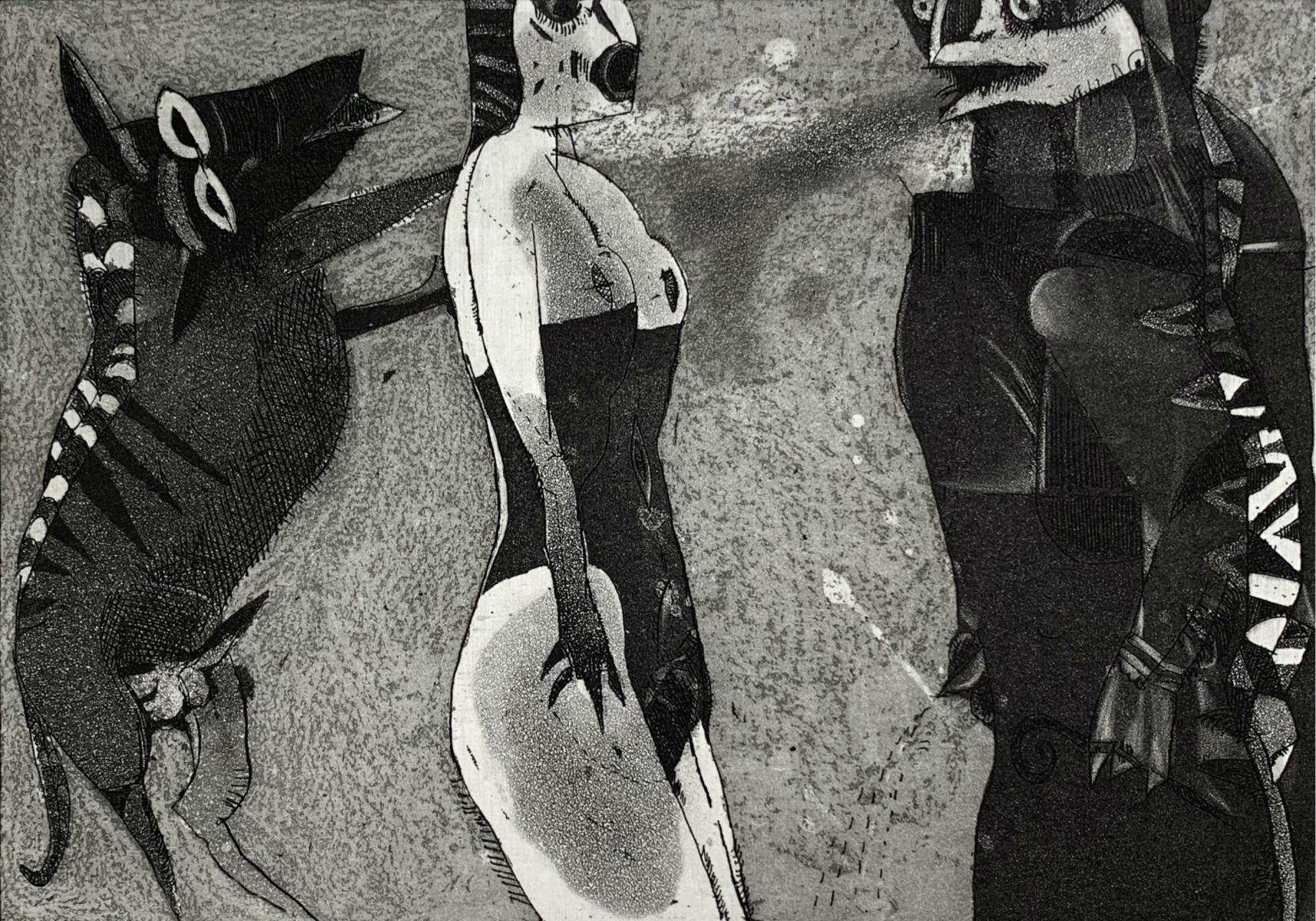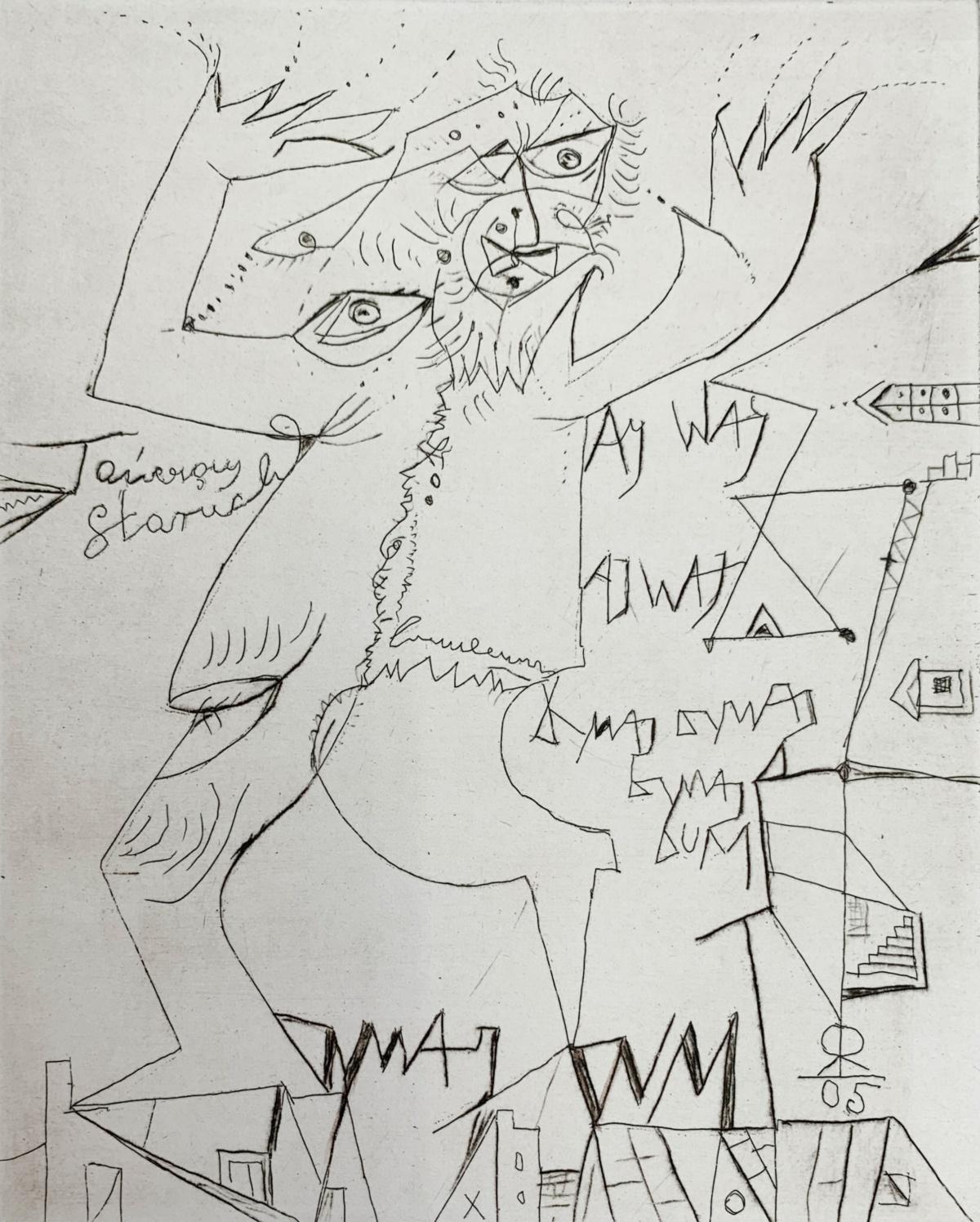Items Similar to The Ringball Player By Rembrandt Van Rijn
Want more images or videos?
Request additional images or videos from the seller
1 of 10
Rembrandt van RijnThe Ringball Player By Rembrandt Van Rijn1654
1654
About the Item
Rembrandt van Rijn
1606-1669 Dutch
The Ringball Player
Etching on paper
New Hollstein’s first state of two
Signed and dated lower left: Rembrandt F. 1654
Among the foremost figures of the Old Masters, the esteemed Dutch artist Rembrandt van Rijn is often regarded as the preeminent etcher in art history. As the most significant Dutch printmaker, his body of work includes nearly 300 authenticated prints, marked by pioneering techniques that set new standards in the medium. This exceptional etching, titled The Ringball Player, exemplifies the intricate artistry and meticulous detail that distinguish Rembrandt's prints.
This print is closely related to the ones of the early life of Christ, etched in the same year, and of a similar size, using long straight hatching lines to model the figures and the background. In Rembrandt’s oeuvre, this is also one of the very rare subject matters connected with sports and leisure time. The title refers to ringball, a reference to a form of indoor croquet called beugelen, which involves a spade-like scoop. It was a popular pastime in 16th and 17th century Holland.
The son of a miller, Rembrandt van Rijn is believed to have been born in Leiden on July 15, 1606. He studied first at the Latin School and then was enrolled at the University of Leiden at the age of 14. He soon left to study art — first with a local master, Jacob van Swanenburch, and then, in Amsterdam, with Pieter Lastman, known for his historical paintings. Rembrandt was an exceptionally gifted student and mastered his craft in a mere six months. At 22 years old, he returned to Leiden and was soon so highly regarded that he was able to take students of his own.
Though known today primarily for his paintings, Rembrandt’s fame spread outside of the Netherlands thanks to his etchings. He made hundreds of etchings throughout his career from 1626 until 1660, the year he was forced to sell his presses. He created etchings of numerous subjects, including self-portraits, biblical subjects, saints and allegories, and his work was avidly admired and collected, even during his lifetime.
Dated 1654
Etching: 3 7/8" high x 6 3/4" wide (9.84 x 17.15 cm)
Frame: 20 1/4" high x 16 1/4" wide (51.12 x 41.28 cm)
Provenance:
Unidentified, initials fB in brown ink verso
Dr. Edward Peart (1756/58-1824)
London and Butterwick
Christie’s London, 1822, lot 77
William Benoni White, London
Christie’s London, 1879, lot 290
Sir Byron Edmund Walker, Toronto
Art Gallery of Ontario, Toronto
Private collection, The Netherlands, 2021
M.S. Rau, New Orleans
Literature
Bartsch, Adam. Catalogue Number 125. In Le Peintre graveur.
Hind, Arthur M. Catalogue Number 272. In A Catalogue of Rembrandt’s Etchings.
Nowell-Usticke, G. W. C1. In A Descriptive Catalogue of Rembrandt’s Etchings. 1967.
The New Hollstein Dutch. Catalogue Number 282: The First State (of II), Plate in Existence.
- Creator:Rembrandt van Rijn (1606 - 1669, Dutch)
- Creation Year:1654
- Dimensions:Height: 20.13 in (51.14 cm)Width: 16.25 in (41.28 cm)Depth: 0.88 in (2.24 cm)
- Medium:
- Movement & Style:
- Period:
- Condition:
- Gallery Location:New Orleans, LA
- Reference Number:
Rembrandt van Rijn
Rembrandt was the most influential 17th Century Dutch painter. After years of early success as a portrait painter, his life was beset by financial hardship and personal tragedy. He continued to paint portraits and develop etchings. Rembrandt's portraits of his contemporaries, self-portraits and illustrations of scenes from the Bible are regarded as his greatest creative triumphs. His self-portraits form a unique and intimate autobiography, in which the artist surveyed himself without vanity and with the utmost sincerity. Like many artists of the Dutch Golden Age, such as Jan Vermeer of Delft, Rembrandt was also an avid art collector and dealer. Rembrandt never went abroad, but he was considerably influenced by the work of the Italian masters and Netherlandish artists who had studied in Italy, like Pieter Lastman, the Utrecht Caravaggists, Flemish Baroque, and Peter Paul Rubens. Rembrandt's foremost contribution in the history of printmaking was his transformation of the etching process from a relatively new reproductive technique into a true art form, along with Jacques Callot. His reputation as the greatest etcher in the history of the medium was established in his lifetime and never questioned since. Few of his paintings left the Dutch Republic while he lived, but his prints were circulated throughout Europe, and his wider reputation was initially based on them alone.
About the Seller
5.0
Vetted Seller
These experienced sellers undergo a comprehensive evaluation by our team of in-house experts.
Established in 1912
1stDibs seller since 2013
15 sales on 1stDibs
Typical response time: 3 hours
- ShippingRetrieving quote...Ships From: New Orleans, LA
- Return PolicyThis item cannot be returned.
More From This SellerView All
- Moses and the Pillar of Cloud by Lucas Cranach the Elder and StudioBy Lucas Cranach the ElderLocated in New Orleans, LALucas Cranach the Elder and Studio 1472-1553 German Moses and the Pillar of Cloud Oil on panel Moses and the Pillar of Cloud is a bold and evocative composition that showcases the signature intense color and intricate detail of Lucas Cranach the Elder’s celebrated oeuvre. The remarkable 16th-century oil on panel by Lucas Cranach and his studio captures the narrative moment when Moses leads the Israelites out of Egypt and encounters God manifested through a large pillar of cloud. Moses stands at the precipice of a bridge and turns back to soldiers helping to lead the group of Israelites who huddle closely together. Cranach depicts Moses with his traditional iconography, rendering the rays of light on his head which came to be interpreted as "horns" in the translation of the Bible. Using his traditional walking staff, Moses gestures toward the pillar, seemingly acknowledging that God will protect the group as they cross the bridge to the other side, leaving exile and entering a promised land. In a nod to Cranach’s Germanic locale, he renders the figures and setting in a manner that feels decisively more akin to European aesthetics than those of the Red Sea. Soldiers wear elaborate, gothic suits of armor that recall the livery of Northern European guardsmen. The terrain appears more like a European forest giving way to a sweeping valley than the arid landscape the Israelites trekked through on their journey across the Red Sea. Though still clearly recounting a story from the Old Testament, Cranach renders the cast of characters and setting in an earthly, familiar manner. This aesthetic shift speaks to Cranach’s own changing beliefs as he found himself at the center of the Protestant Reformation. After first gaining recognition in 1505 as the official painter of Frederick the Wise, Cranach established a thriving painting and print studio in Wittenberg, Germany. Cranach was renowned for his court portraits and genre paintings and was also well known for his association with the famous protestant reformer Martin Luther, then under the protection of Frederick the Wise. As Wittenberg became a bastion of new religious thought, Cranach soon befriended Luther and played an active role in creating the printed materials that proliferated throughout the Reformation...Category
16th Century Old Masters Figurative Paintings
MaterialsOil, Panel
- The Adoration of the Magi by Joseph van BredaelLocated in New Orleans, LAJoseph van Bredael 1688-1739 Flemish The Adoration of the Magi Oil on copper Painted on copper and exhibiting an exquisite luminosity, this exceptional painting...Category
Late 17th Century Old Masters Figurative Paintings
MaterialsCopper
- Leda And The Swan By Workshop Of Bartholomaeus SprangerLocated in New Orleans, LAWorkshop of Bartholomaeus Spranger 16th Century Flemish Leda and the Swan Oil on panel Retelling one of the most legendary Greco-Roman mythological tales, this exceptional oil on...Category
16th Century Old Masters Nude Paintings
MaterialsPanel, Oil
- Portrait Of A Gentleman By Frans HalsLocated in New Orleans, LAFrans Hals 1582-1666 Dutch Portrait of a Gentleman (possibly Theodore Blevet) Oil on panel “Frans Hals is a colourist among the colourists...Frans Hals must have had twenty-seven blacks...Category
17th Century Old Masters Portrait Paintings
MaterialsOil, Panel
- Still Life With Goldfish I By Henri MatisseBy Henri MatisseLocated in New Orleans, LAHenri Matisse (1869-1954) French Still Life with Goldfish I Singed "Monotype / Henri Matisse" Monotype on paper (chine collé) This exceptional work of art encapsulates the genius...Category
20th Century Post-Impressionist Still-life Prints
MaterialsPaper, Monotype
- Ukrainian Dancers By Edgar DegasBy Edgar DegasLocated in New Orleans, LAEdgar Degas 1834-1917 French Ukrainian Dancers Stamped "Degas" (lower left) Charcoal and pastel on tracing paper mounted on cardboard “I’m goin...Category
19th Century Impressionist Figurative Drawings and Watercolors
MaterialsPaper, Charcoal, Pastel, Cardboard
You May Also Like
- 19th century lithograph caricature black and white satirical figurative printBy Honoré DaumierLocated in Milwaukee, WI"Ce Matin Avant l'Aurore" is an original lithograph by Honore Daumier, the second state of three. Original Text: Ce matin, avant l'aurore, Un Dieu vint me réveiller ; Il me dit : tu dors encore… Est-il temps de sommeiller ? De ton Papa c’est la fête, Fais lui quelque don flatteur En lui posant sur la tête Une Couronne de fleurs. Translation: This morning before dawn A God came to wake me up The curtains they were drawn And my snoring had to stop It is your daddy's birthday, A time for gifts and flowers To be placed on his head so gray Instead of his morning showers. Artwork Size: 9 1/4" x 9 1/4" Frame Size: 20 1/2" x 17 5/8" Artist Bio: Daumier was a prolific draftsman who produced over 4000 lithographs, he was perhaps best known for his caricatures of political figures and satires on the behavior of his countrymen, although posthumously the value of his painting has also been recognized. His works offer a commentary on social and political life in France in the 19th century. French caricaturist and painter, born at Marseilles. He showed in his earliest youth an irresistible inclination towards the artistic profession, which his father vainly tried to check by placing him first with a huissier, and subsequently with a bookseller. Having mastered the technique of lithography, Daumier started his artistic career by producing plates for music publishers, and illustrations for advertisements; these were followed by anonymous work for publishers, in which he followed the style of Charlet and displayed considerable enthusiasm for the Napoleonic legend. When, in the reign of Louis-Philippe, Philipon launched the comic journal, La Caricature, Daumier joined its staff, which included such powerful artists as Devéria, Raffet and Grandville, and started upon his pictorial campaign of scathing satire upon the foibles of the bourgeoisie, the corruption of the law and the incompetence of a blundering government. His caricature of the king as "Gargantua" led to Daumier's imprisonment for six months at Ste. Pélagie in 1832. The publication of La Caricature was discontinued soon after, but Philipon provided a new field for Daumier's activity when he founded the Charivari. For this journal Daumier produced his famous social caricatures, in which bourgeois society is held up to ridicule in the figure of Robert Macaire, the hero of a then popular melodrama. Another series, "L'Histoire Ancienne", was directed against the pseudoclassicism which held the art of the period in fetters. In 1848 Daumier embarked again on his political campaign, still in the service of Charivari, which he left in 1860 and rejoined in 1864. In spite of his prodigious activity in the field of caricature -- the list of Daumier's lithographed plates compiled in 1904 numbers no fewer than 3958 -- he found time for flight in the higher sphere of painting. Except for the searching truthfulness of his vision and the powerful directness of his brushwork, it would be difficult to recognize the creator of Robert Macaire, of Les Bas bleus, Les Bohémiens de Paris, and the Masques, in the paintings of "Christ and His Apostles" at the Ryks Museum in Amsterdam, or in his "Good Samaritan", "Don Quixote and Sancho Panza", "Christ Mocked...Category
1830s Old Masters Figurative Prints
MaterialsLithograph
- Antique Copper Engraving of an Officer of Pikeman by Francis GroseBy Francis GroseLocated in New York, NYFrancis Grose entered the army early in life and served in the cavalry, infantry, and militia. He produced some compelling and sought after engravings on subjects including ancient a...Category
19th Century Old Masters Figurative Prints
MaterialsLithograph
- Transformation No. 37, 1993 by Karl Gerich of Bath - Playing Card Print SheetLocated in Meinisberg, CHKarl Alexander Gerich (English, 23.4.1956 - 4.1.2016) - Etching - Transformation, No. 37, 1993 - Sheet 41.5 x 29.7 cm - Plate 22.3 x 30.1 cm Worldwide shipping for this object is complimentary - There are no additional charges for handling & delivery. A finished but uncolored sheet from Karl’s masterpiece - The Nursery Rhymes Transformation Playing Cards produced for the E. P. C. S. 10th Anniversary in 1993. This sheet of nine transformation playing card designs whose designs are based on nursery rhymes and in the suit of diamonds (2-9). Sheet is in good condition and suitable to be framed. Karl was a brilliant playing card maker and certainly one of the most genius artist-craftsmen I had the pleasure to learn about his work and know. He could do it all: Come up with the tale, weave meaning(s) into it, fill it with spirited characters of his liking, draw it, etch it, print it, colour it and handcraft the inks, paper and card into wondersome packs of playing cards, each of them living in their own, most exquisitely crafted boxes. Every pack a magical marvel, filled with the spirit of this genius card maker … All this he did using his Adana printing press, very simple hand tools and great skill. When Karl closed down his studio in St.Peter’s Terrace in Bath, England and moved to Poplar Close, he sold off work for which he felt he no longer wanted to be the custodian. So a number of prints reached the market then. Printed sheets by Karl Gerich...Category
1990s Naturalistic Figurative Prints
MaterialsPaper, Ink, Etching
- Beautiful Bath , No. 23 1996 by Karl Gerich of Bath - Playing Card Proof PrintLocated in Meinisberg, CHKarl Alexander Gerich (English, 23.4.1956 - 4.1.2016) Beautiful Bath No. 23, 1996 - Etching - Sheet ca. 29.9 x 29.9 cm - No plate mark (trimmed sheet) Worldwide shipping for this object is complimentary - There are no additional charges for handling & delivery. This pack is said to be Karl’s declaration of Love to his chosen city of Bath. Each card narrates a part of Bath’s rich history. The court cards depict portraits of personalities – real and legendary – who shaped the city of Bath as it is today. Unfinished, proof print with depictions of the court cards of diamonds and clubs, but an empty cartouche where Karl himself will appear at a later state as the joker, playing mandolin. On one of the documenting photos you can see a photo copy of what the joker card would look like. Sheet is in good condition and suitable to be framed. Karl was a brilliant playing card maker and certainly one of the most genius artist-craftsmen I had the pleasure to learn about his work and know. He could do it all: Come up with the tale, weave meaning(s) into it, fill it with spirited characters of his liking, draw it, etch it, print it, colour it and handcraft the inks, paper and card into wondersome packs of playing cards, each of them living in their own, most exquisitely crafted boxes. Every pack a magical marvel, filled with the spirit of this genius card maker … All this he did using his Adana printing press, very simple hand tools and great skill. When Karl closed down his studio in St.Peter’s Terrace in Bath, England and moved to Poplar Close, he sold off work for which he felt he no longer wanted to be the custodian. So a number of prints reached the market then. Printed sheets by Karl Gerich...Category
1990s Naturalistic Figurative Prints
MaterialsPaper, Ink, Etching
- Don't be afraid - XX Century figurative etching print, Black & white, SurrealismBy Jacek SrokaLocated in Warsaw, PLZBIGNIEW LUTOMSKI He was born in 1934 in Grodno. Polish graphic designer, painter and teacher. He studied at the Academy of Fine Arts in Krakow, where in 1960 he obtained a diploma. ...Category
21st Century and Contemporary Contemporary Figurative Prints
MaterialsPaper, Etching
- A dancing one - XXI Century, Figurative etching print, Black & whiteBy Leszek RózgaLocated in Warsaw, PLLESZEK RÓZGA (1924-2015) He studied painting at Maria Skarbek-Kruszewska private atelier in 1945-46. In 1948, he began studies at the art school in Łódź (later: Academy of Fine Arts)...Category
Early 2000s Contemporary Figurative Prints
MaterialsEtching, Paper
Recently Viewed
View AllRead More
Wear Louis Comfort Tiffany’s Genius on Your Finger with This Vivid Ring
In his jewelry making, the designer rarely used diamonds — this rare example has two.
You Won’t Find a More Handsome Stopwatch Than This 1890s Pocket Chronograph
A Grand Complication from the golden era of pocket watches, the Marius Lecoultre pocket watch does everything but uncork your wine.

